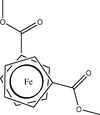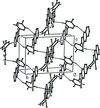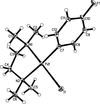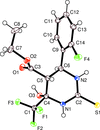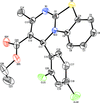issue contents
May 2015 issue

Cover illustration: Variously substituted N-aryl-4-oxo-4H-chromene-3-carboxamide derivatives present planar conformations between the carboxamide moiety and the chromone ring stabilized by intramolecular N-H O hydrogen bonding. Despite the similarity in structures, they function differentially as h-MAO-B inhibitors, an observation correlated with the electronic moderation induced by the substituents in the exocyclic aryl ring. See: Gomes, Low, Cagide, Chavarria & Borges [Acta Cryst. (2015). E71, 547-554].
O hydrogen bonding. Despite the similarity in structures, they function differentially as h-MAO-B inhibitors, an observation correlated with the electronic moderation induced by the substituents in the exocyclic aryl ring. See: Gomes, Low, Cagide, Chavarria & Borges [Acta Cryst. (2015). E71, 547-554].
research communications
Download citation


Download citation


In Na9Cr(MoO4)6 the basic structure units are isolated polyhedral clusters composed of a central CrO6 octahedron sharing vertices with six MoO4 to form an open (0D) framework in which the Na+ cations are oriented at the free vertices of the MoO4 tetrahedra.
CCDC reference: 1055835
Download citation


Download citation


The synthesis and crystal structure of a ZnII complex with a (3,4-dihydronaphthalen-1(2H-ylidene)-N-phenyl-carbamohydrazinothioate ligand is reported. The crystal structure shows DMSO molecules bridging the complex units, building an one-dimensional H-bonded polymer.
CCDC reference: 1056177
Download citation


Download citation


In the first reported crystal structure of the family of lithium phosphate diesters, the Li atom is in a slightly distorted tetrahedral coordination environment and exhibits one intramolecular O—H⋯O hydrogen bond between a coordinating methanol molecule and the terminal non-coordinating O atom of the phosphate group. The unit is connected with two non-coordinating methanol molecules through two intermolecular O—H⋯O hydrogen bonds and with a neighbouring unit through two other O—H⋯O interactions.
CCDC reference: 1054771
Download citation


Download citation


8-(Diphenylphosphanyl)quinoline (Ph2Pqn) acts as an asymmetric bidentate ligand to form a planar five-membered chelate ring in the dichloridopalladium(II) and -platinum(II) complexes, (SP-4)-[MCl2(Ph2Pqn)] (M = Pd or Pt), as well as in the dichloridorhodium(III) complex, (OC-6-32)-[RhCl2(Ph2Pqn)2]PF6.
Download citation


Download citation


Crystal structure of bis(azido-κN)bis[2,5-bis(pyridin-2-yl)-1,3,4-thiadiazole-κ2N2,N3]cobalt(II)
The structure of the title compound is isotypic with that of the analogous nickel(II) complex, in which the CoN6 core shows an axially weakly compressed octahedral geometry as opposed to the almost regular geometry exhibited by the NiN6 octahedron.
CCDC reference: 1057234
Download citation


Download citation


NaRb2(NO3)3 nitrate is the only intermediate compound in the system NaNO3 + RbNO3. It has, according to a thermal study, three allotropic forms. The structure of the low-temperature form is presented.
CCDC reference: 1004334
Download citation


Download citation


In a Ba coordination polymer incorporating 4-nitro-2,5,6-trioxo-1,2,5,6-tetrahydropyridin-3-olate, oxalate and aqua ligands, the complex monomers are connected into polymeric two-dimensional layers parallel to the bc plane. Intermolecular O—H⋯O hydrogen bonds link these layers into a three-dimensional supramolecular framework.
CCDC reference: 1057170
Download citation


Download citation


The first crystal structure determination of a 1:2 co-crystalline adduct of 1,3,6,8-tetraazatricyclo[4.4.1.13,8]dodecane is presented. In the crystal, adducts are linked by C—H⋯O and C—H⋯Br hydrogen bonds, forming a two-dimensional network.
CCDC reference: 1057775
Download citation


Download citation


In the title three compounds, the ring conformations of tetracycles are similar; each tetracycle adopts essentially planar, chair, half-chair and chair–chair forms. In the crystals, molecules are linked into similar chains by intermolecular hydrogen bonds.
Download citation


Download citation


The title salt consists of a dimethylammonium cation (Me2NH2+), an hydrogenoxalate anion (HC2O4−), and half a molecule of oxalic acid (H2C2O4) situated about an inversion center. They are linked together through intermolecular hydrogen bonds, forming a two-dimensional bilayer-like self-assembly.
CCDC reference: 1055825
Download citation


Download citation


In the crystal of the title salt, the 2,6-diamino-4-oxo-1,3-dihydropyrimidin-1-ium cations and the p-toluenesulfonate anions are linked by a series of N—H⋯O hydrogen bonds, forming tunnel-like polymer chains propagating along [010].
CCDC reference: 1057933
Download citation


Download citation


The asymmetric unit of the title zinc(II) coordination polymer contains two 4-nitrobenzoate (NB) anions and two nicotinamide (NA) ligands. Only one of the two NB anions and one of the two NA ligands bridge adjacent ZnII ions through eight- and 12-membered rings, respectively, forming polymeric chains running along the a-axis direction.
CCDC reference: 1057121
Download citation


Download citation


The title compound shows two packing polymorphs, in which the molecular structures are planar and essentially similar. One crystal shows intermolecular C—H⋯O and π–π interactions, while the other crystal exhibits several modes of intermolecular C—H⋯O interactions.
Download citation


Download citation


The title compound crystallizes in the keto form and the carbonyl O atom forms an intramolecular N—H⋯O hydrogen bond with the neighbouring NH group. In the crystal, molecules are linked by pairs of N—H⋯O hydrogen bonds to form inversion dimers, which are linked via pairs of C—H⋯O hydrogen bonds, forming chains propagating along [100].
CCDC reference: 1056718
Download citation


Download citation


In the title compound, the ring conformations of the tetracycle are twist, chair, half-chair and chair–boat forms. In the crystal, intermolecular C—H⋯O and C—H⋯π interactions link molecules to construct a three-dimensional architecture.
CCDC reference: 1058739
Download citation


Download citation


The crystal structure of calcium levulinate dihydrate forms a one-dimensional coordination polymer based on a CaO8 complex unit which lies on a twofold rotation axis. This unit comprises two monodentate water O-atom donors and six carboxylate O-atom donors, two of which are also bridging, from the two bidentate chelate levulinate ligands. The complex chains are stabilized by intra- and intermolecular water O—H⋯O hydrogen bonds, forming an overall three-dimensional structure.
CCDC reference: 1057749
Download citation


Download citation


In a novel one-dimensional hybrid compound, the inorganic part contains zigzag chains formed by corner-sharing [SbCl6]3− octahedra. 1,4-Diazoniabicyclo[2.2.2]octane dications cations are lodged around the anionic framework. Water molecules play an important role in the structure connectivity.
CCDC reference: 943047
Download citation


Download citation


The high-pressure phase of SrGeO3 synthesized at 6 GPa and 1223 K adopts the ideal cubic perovskite-type structure. The Ge—O bond is largely covalent, which influences the thermal vibration behavior of the O atom.
CCDC reference: 1059192
Download citation


Download citation


The crystal structure and supramolecular features of 5-{3-[2,6-dimethyl-4-(5-methyl-1,2,4-oxadiazol-3-yl)phenoxy]propyl}-N-(11-hydroxyundecyl)isoxazole-3-carboxamide hemihydrate, a derivative of antiviral `WIN compounds', are reported.
CCDC reference: 1059505
Download citation


Download citation


In each of the title compounds, the anion shows evidence of extensive electronic delocalization. A combination of N—H⋯N and X—H⋯N hydrogen bonds links the ions in (I) into a ribbon of alternating centrosymmetric  (18) and
(18) and  (26) rings, and those in (II) into simple
(26) rings, and those in (II) into simple  (7) chains of alternating cations and anion with further cations pendent from the chain.
(7) chains of alternating cations and anion with further cations pendent from the chain.
Download citation


Download citation


The title compound is the first reported characterized 2:2 product from acid-catalyzed condensation of indole with cyclopentanone. In the crystal, molecules are connected by a series of N—H⋯π and C—H⋯π interactions, forming slabs parallel to (010).
CCDC reference: 1059822
Download citation


Download citation


N—H⋯O, N—H⋯Cl and O—H⋯O hydrogen bonds between cations and anions in the complex salt (C4H7N2)+[Sn(H2O)Cl3(C2O4)]− are responsible for the formation of a three-dimensional network structure.
CCDC reference: 1056053
Download citation


Download citation


The title compounds were synthesized via an Arbuzov reaction between an α-bromoketone and isopropoxydiphenylphosphane. In the crystals of both compounds, molecules are linked via bifurcated C—H⋯(O,O) hydrogen bonds, forming chains propagating along [100] and along [010].
Download citation


Download citation


While attempting to synthesize a cyclopentadienyl iridium complex by the reaction between IrCl3·xH2O in methanol, several well-shaped crystals formed from the reaction mixture. Surprisingly, the crystals were of di-μ-chlorido-bis[dichloridobis(methanol-κO)iridium(III)] dihydrate, [Ir2Cl6(CH3OH)4]·2H2O. This is a surprising result in that, while many reactions of iridium chloride hydrate are carried out in alcoholic solvents, especially methanol and ethanol, this is the first structure of a chlorido-iridium compound with only methanol ligands.
CCDC reference: 1057748
Download citation


Download citation


Centrosymmetric dimers with a central  (8) ring motif are formed as a result of (carboxyl)O—H⋯O(carboxyl) hydrogen bonds. In addition, there is an intramolecular (hydroxyl)O—H⋯O(carboxyl) hydrogen-bonding interaction.
(8) ring motif are formed as a result of (carboxyl)O—H⋯O(carboxyl) hydrogen bonds. In addition, there is an intramolecular (hydroxyl)O—H⋯O(carboxyl) hydrogen-bonding interaction.
CCDC reference: 1059331
Download citation


Download citation


The solid-state structure of a disubstituted ferrocene with electrochemically active pendant groups has been determined. This is a potential chemotherapeutic drug.
CCDC reference: 1054149
Download citation


Download citation


The CrIII atoms in the title compound show a distorted octahedral coordination with four N atoms of the cyclam ligand in the equatorial plane and two N-coordinated NCS− groups in axial positions. The macrocyclic ligands adopt trans-III configurations. The crystal packing is stabilized by N—H⋯S and N—H⋯Cl hydrogen bonds.
CCDC reference: 1059896
Download citation


Download citation


In the title compound, the silver atom is coordinated by two 1,3-bis(2,6-dimethylphenyl)imidazol-2-ylidene ligands, with the imidazole rings inclined to one another by 46.69 (13)°. In the crystal, molecules are linked by trifurcated C—H⋯(Cl,Cl,Cl) hydrogen bonds, forming two-dimensional networks parallel to (010).
CCDC reference: 1060013
Download citation


Download citation


N-(Substituted phenyl)-4-oxo-4H-chromene-3-carboxamides have very similar conformations but show different inhibition activities against h-MAO-B so it may be assumed that the electronic environment provided by the substituents on the phenyl ring is the primary condition for the pharmacological activities displayed by these molecules.
Download citation


Download citation


In the structure of bis(2-amino-5-chloropyridinium) tetrachloridocobaltate(II), the essentially planar cations are connected through N—H⋯Cl hydrogen bonds to the tetrahedral anion.
CCDC reference: 990478
Download citation


Download citation


The transition metal orthophosphates Na2M2Fe(PO4)3 (M = Co, Ni) crystallize in an alluaudite-type structure. The chains characterizing the alluaudite structure are then built up from [M2O10] units alternating with [FeO6] octahedra.
CCDC reference: 1060932
Download citation


Download citation


In the title complex, the CoII atom is located on an inversion centre and is coordinated by two 4-cyanobenzoate (CNB) anions, two nicotinamide (NA) ligands and two water molecules. The four O atoms in the equatorial plane form a slightly distorted square-planar arrangement, while the slightly distorted octahedral coordination sphere is completed by the two N atoms of the NA ligands in the axial positions.
CCDC reference: 1061935
Download citation


Download citation


The zwitterionic title compound shows a major disorder of the triisopropylphenyl group over two equally occupied locations. An interesting feature is the uncommon hydrate structure, exhibiting a tape-like motif which can be classified as a transition of the one-dimensional T4(2)6(2) motif into the two-dimensional L4(6)5(7)6(8) motif.
CCDC reference: 1061352
Download citation


Download citation


The crystal structure and supramolecular features of 3-chloro-2-(4-methylphenyl)-2H-pyrazolo[3,4-b]quinoline are reported.
CCDC reference: 1012361
data reports
inorganic compounds
Download citation


Download citation


metal-organic compounds
Download citation


Download citation


Download citation


Download citation


Download citation


Download citation


Download citation


Download citation


Download citation


Download citation


Download citation


Download citation


Download citation


Download citation


Download citation


Download citation


Download citation


Download citation


Download citation


Download citation


Download citation


Download citation


Download citation


Download citation


Download citation


Download citation


Download citation


Download citation


organic compounds
Download citation


Download citation


Download citation


Download citation


Download citation


Download citation


Download citation


Download citation


Download citation


Download citation


Download citation


Download citation


Download citation


Download citation


Download citation


Download citation


Download citation


Download citation


Download citation


Download citation


Download citation


Download citation


Download citation


Download citation


Download citation


Download citation


Download citation


Download citation


Download citation


Download citation


Download citation


Download citation


Download citation


Download citation


Download citation


Download citation


Download citation


Download citation


Download citation


Download citation


Download citation


Download citation


Download citation


Download citation


Download citation


Download citation


Download citation


Download citation


Download citation


Download citation


Download citation


Download citation


Download citation


Download citation


Download citation


Download citation


Download citation


Download citation


Download citation


Download citation


Download citation


Download citation


Download citation


Download citation


Download citation


Download citation


Download citation


Download citation


Download citation


Download citation


Download citation


Download citation


Download citation


Download citation


Download citation


Download citation


Download citation


Download citation


Download citation


Download citation


Download citation


Download citation


Download citation


Download citation


Download citation


Download citation


Download citation


Download citation


Download citation


Download citation


Download citation


Download citation


Download citation


Download citation


Download citation


Download citation


Download citation


Download citation


Download citation


Download citation


Download citation


Download citation


Download citation


Download citation


Download citation


Download citation


Download citation


Download citation


Download citation


Download citation


Download citation


Download citation


Download citation


Download citation


Download citation


Download citation




 journal menu
journal menu




































